Gigabyte Aorus Gen5 10000 review: The first PCIe 5.0 SSD makes a splash
 At a glance
At a glance
Expert’s Rating
Pros
- Fastest sustained performance we’ve seen
- Massive heatsink for gamers
- State-of-the-art PCIe 5.0 and NVMe 2.0
Cons
- Relatively weak random performance
- Low TBW rating for the price
- Requires the rare PCIe 5.0 M.2 slot
Our Verdict
Though the Aorus Gen5 10000 offers super-fast sustained transfers, it’s pricey and has the same random performance as cheaper PCIe 4.0 SSDs.
Gigabye’s Aorus Gen5 10000 is easily the fastest single NVMe SSD we’ve tested. Being the first PCIe 5.0 drive we’ve tested, that’s hardly surprising. But it is quite delightful to see a drive sustain reads and writes over 10GBps.
What are the Gigabyte Aorus Gen5 10000 specs?
The Aorus Gen5 10000 wouldn’t be much to look at on its own. It’s your usual 2280 (22mm wide, 80mm long) M.2 NVMe SSD with a plain-ish black label. That’s if you omit the massive heatsink that Gigabyte provides. And I mean massive. See below.
Further reading: See our roundup of the best SSDs to learn about competing products.
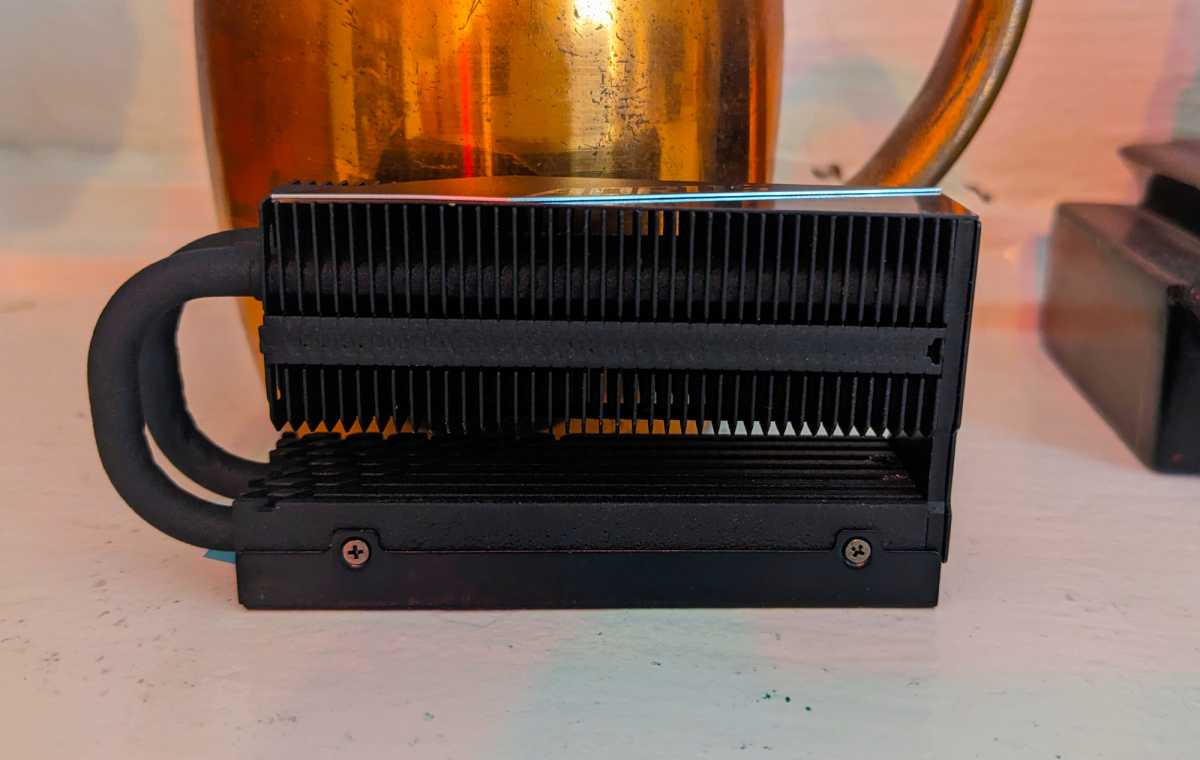
The massive heatsink that accompanies the Auros Gen5 10000 in the box.
Jon L. Jacobi
This heatsink is overkill for most users, and during our benchmarking the drive ran relatively cool, never once threatening to throttle during multiple benchmark runs.
The Gen5 10000 uses Phison’s new E26 controller and the latest 232-layer 3D TLC NAND. Though the drive is not widely available yet, we did see it available online for $340 in the 2TB flavor we tested. That’s roughly twice what a bargain 2TB PCIe 4.0 drive will cost, and three times a PCIe 3.0 SSD.
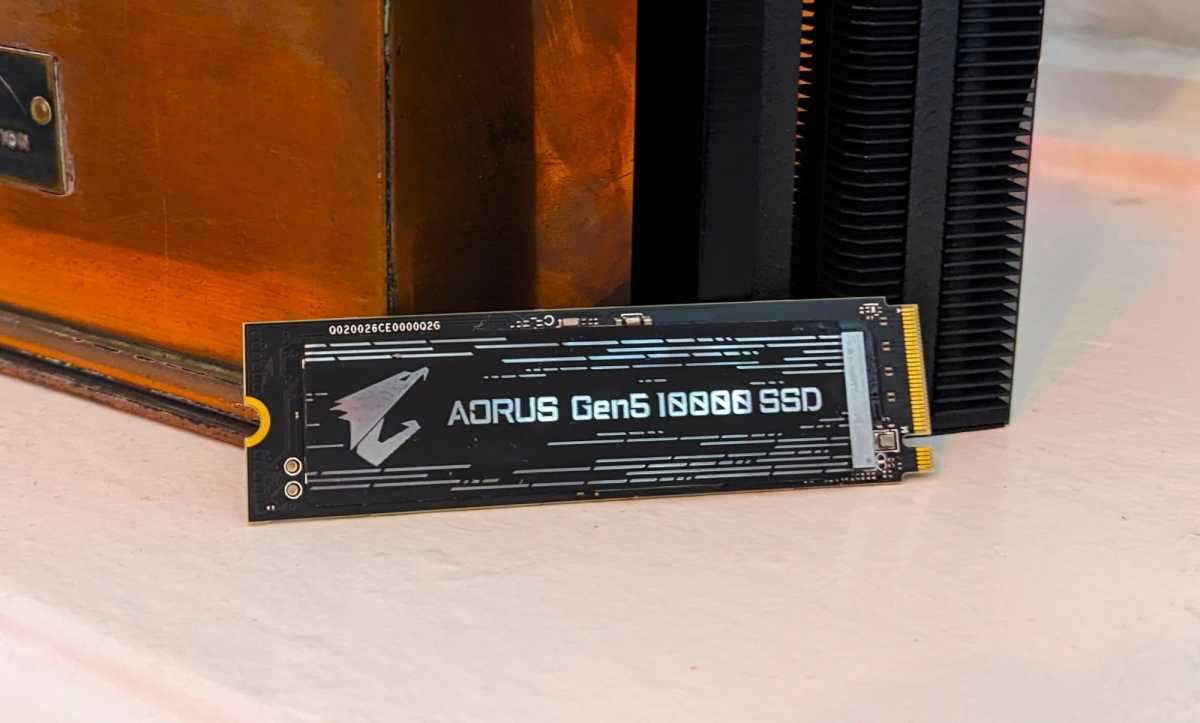
The Gigabyte Auros Gen5 10000 without its heatsink.
Jon L. Jacobi
The drive is covered by a limited five-year warranty. The limit is a 700TBW (terabytes that may be written) per 1TB of capacity rating. That’s not very generous given the rather steep pricing, though some of that pricing reflects the presence of the huge heatsink.
How fast is the Gigabyte Aorus Gen5 10000?
Does PCIe 5 make a difference? Yes. Big time, if you go by synthetic benchmarks; marginally, if you go by real-world transfers. As you can see below, the Aorus Gen5 10000 destroyed the competition in CrystalDiskMark 8’s sustained throughput tests.
Said competition was the WD SN850X, the fastest PCIe 4.0 SSD we’ve tested, and the Crucial P3 which is a very fast entry-level PCIe 3.0 SSD. The three drives should give you a good idea of the relative performance across the generations of PCIe. Note that the Gen5 10000 is also NVMe 2.0 where the others are 1.4 max.
The Aorus Gen5 10000 destroyed the competition in CrystalDiskMark 8’s sustained throughput tests.
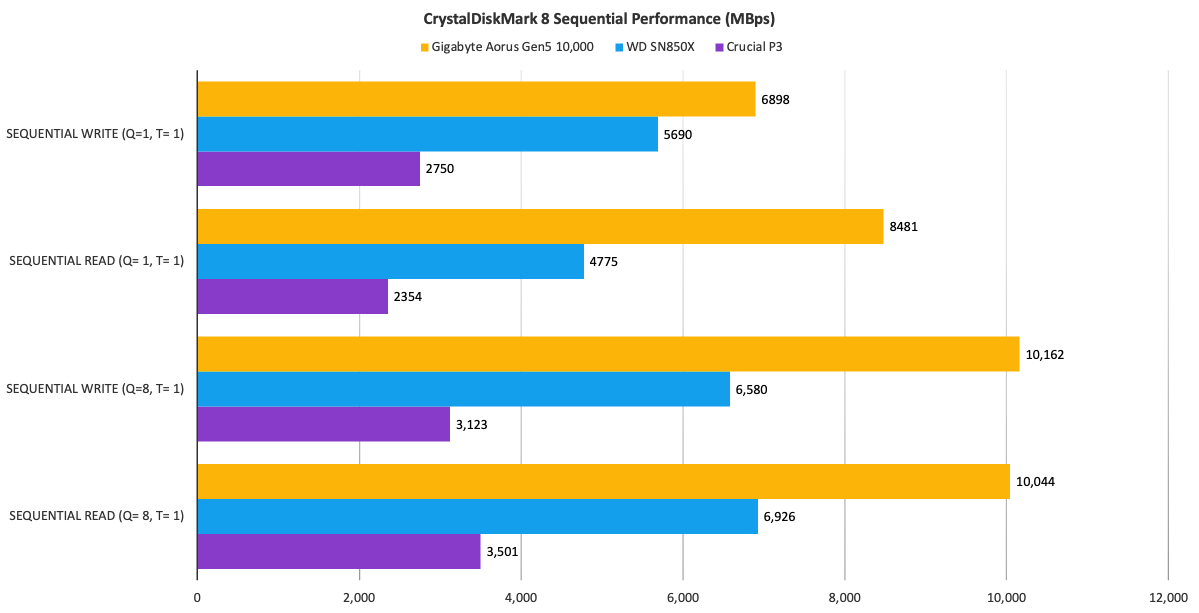
Sobering the discussion quite a bit is the lack of effect that PCIe 5.0 seems to have with random performance. Indeed, if these numbers are to be believed, you’re better off running your operating system with the WD SN850X than the Aorus Gen5 10000. Save the latter for large file transfers.
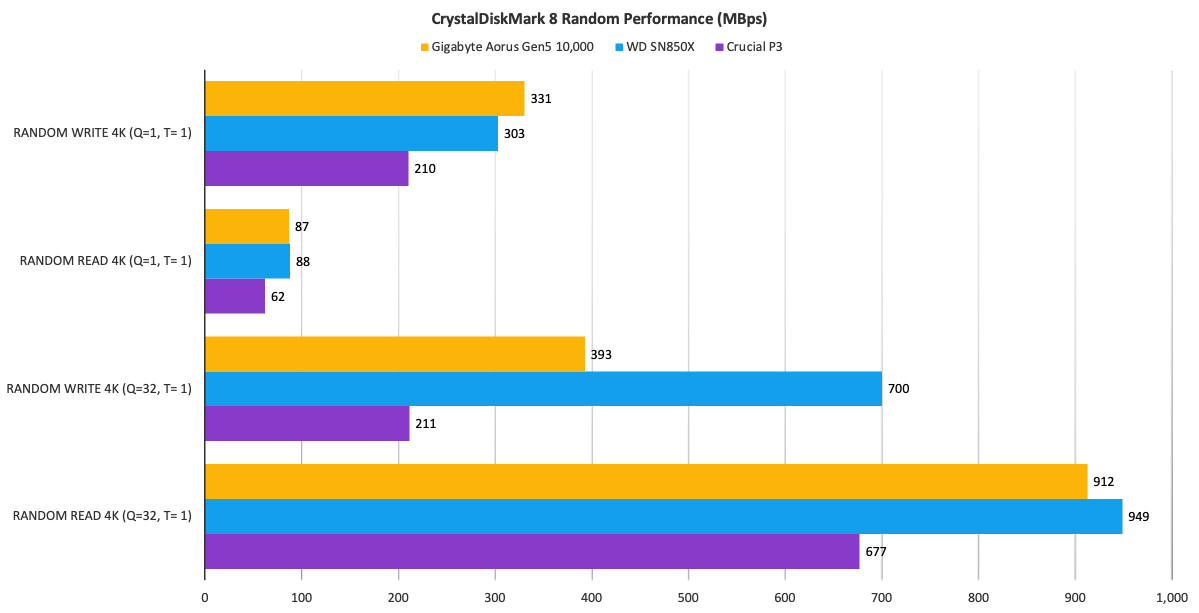
In our real-world 48GB transfers, the Gen5 10000 is indeed faster than previous generations, but again, not by the same large margins we saw in the synthetic benchmarks. Note that there are PCIe 4.0 SSDs that are even faster in this test than the SN850X.
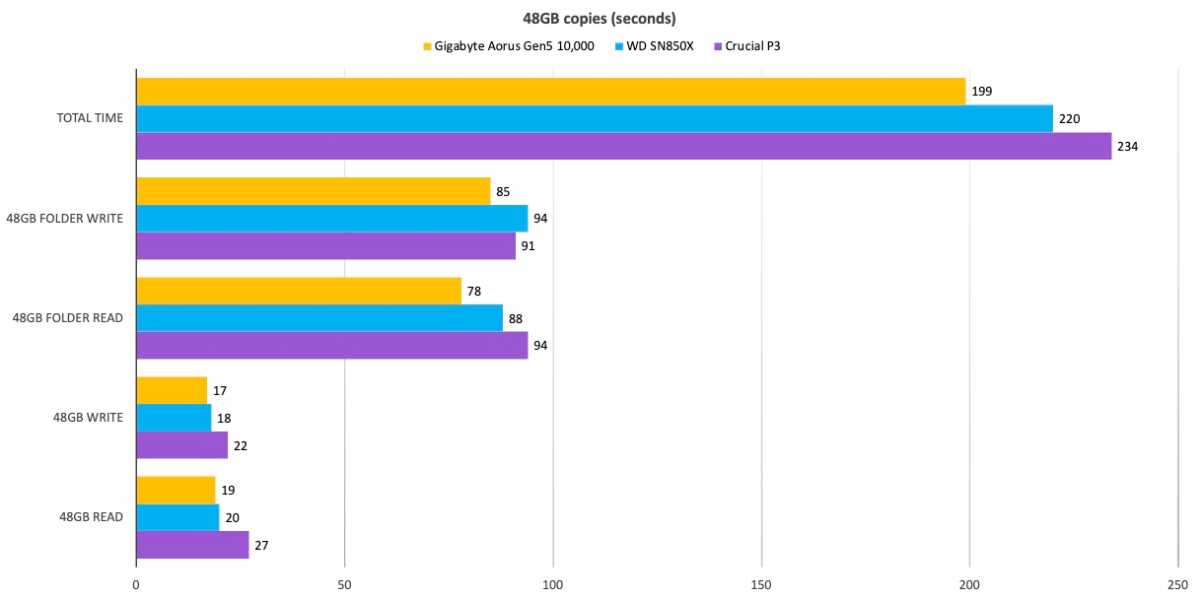
Again, during our 450GB write test shown below, the margin of victory, while welcome, was decidedly underwhelming. However, this test is also dependent upon the drive transferring the file (a Samsung 990 Pro). We actually run this test to see if the transfer bogs down at any point due to lack of, or poor secondary NAND caching (writing as single-bit SLC rather than three-bit TLC).
All three drives are 2TB, meaning secondary cache shouldn’t factor in, and didn’t slow at any point.
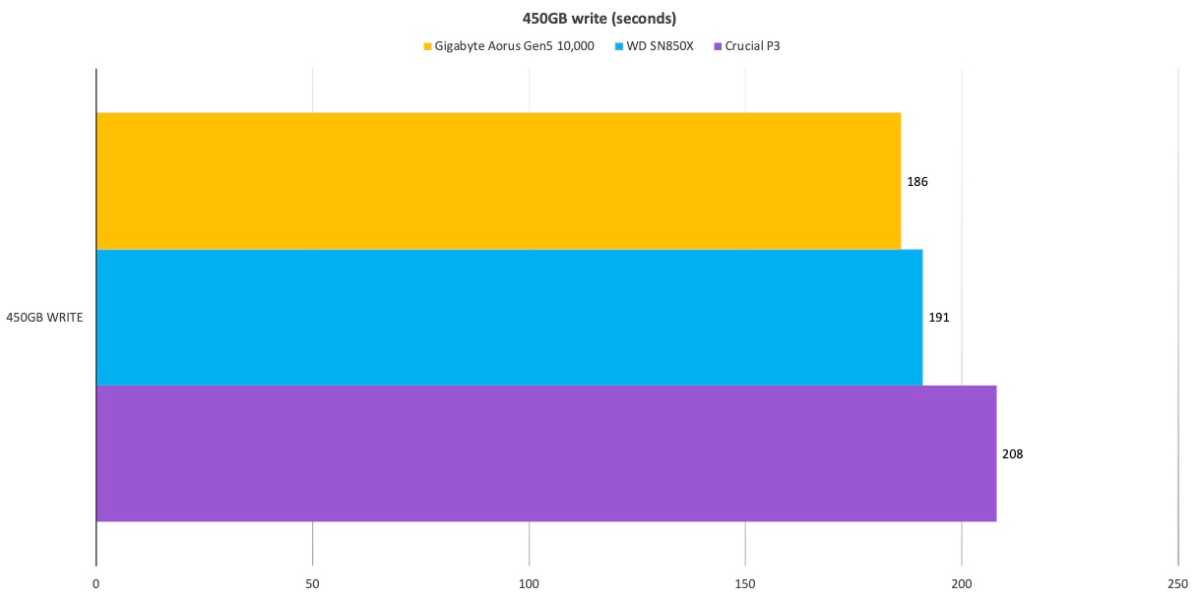
One thing I did notice is that the Gen5 10000 is relatively slow formatting, taking up to 15 seconds. I’ve experienced this with other SSDs on occasion. It may be that the drive is house-keeping the NAND so that it’s cleared and ready for action without incurring erase-before-write performance penalties before the next TRIM operation occurs.
Internal drive tests currently utilize Windows 11 64-bit running on an X790 (PCIe 5.0) motherboard/i5-12400 CPU combo with two Kingston Fury 32GB DDR5 modules (64GB of memory total). Intel integrated graphics are used. The 48GB transfer tests utilize an ImDisk RAM disk taking up 58GB of the 64GB total memory. The 450GB file is transferred from a Samsung 990 Pro 2TB.
Each test is performed on a newly formatted and TRIM’d drive so the results are optimal. Note that in normal use, as a drive fills up, performance will decrease due to less NAND for caching, as well as other factors.
The performance numbers shown apply only to the drive we were shipped and of the capacity tested. SSD performance can vary by capacity due to more or fewer chips to shotgun reads/writes across and the amount of NAND available for secondary caching. Vendors also occasionally swap components. If you ever notice a large discrepancy between the performance you experience and that which we report (systems being roughly equal), please let us know.
Note that PCWorld just updated its test bed to a new platform with PCIe 5.0 M.2, as well as onboard Thunderbolt/USB4 and 20MBps USB. The test bed now uses integrated Intel graphics in lieu of a discrete GPU. All the SSDs listed in the charts were retested on the new platform, so the numbers may not match those in their individual reviews.
What platform do I need for the Gigabyte Aorus Gen5 10000?
There’s, of course, the elephant in the room: the relative lack of PCIe 5.0 support for SSDs. Though PCIe 5.0 is no longer a rarity in mid- to high-priced motherboards, M.2 slots that support it are. Indeed, picking the motherboard for our test bed was a chore because of this. Also, there’s a dearth of PCIe 5.0 M.2 adapter cards for utilization in the far more common PCIe 5.0 slots.
Then there’s the need for a late model CPU. Only Intel’s 12th- and 13th-gen processors support PCIe 5.0. None of the current Intel chipsets do, so the platform controller hub is still limited to PCIe 4.0.
AMD’s latest Ryzen CPUs support PCIe 5.0, and offer quite a few more lanes so it’s easier to run both graphics cards and SSDs at the new standard. That had us interested, but Intel’s native support for Thunderbolt 4/USB4, which we need to test occasionally, was the difference maker, along with price.
If our considerations aren’t yours, then you’re just as well off with AMD for PCIe 5.0 SSDs.
Is the Gigabyte Aorus Gen5 10000 worth it?
There’s no doubt that the Aorus Gen5 10000 is the fastest NVMe SSD for sustained throughput that we’ve tested. On the other hand, it’s pricey, and you of course need a PCIe 5.0 M.2 slot to take advantage of it. If you have the cash, and your system qualifies—you’ll like it. And you’ll know that you’re getting some of the fastest performance available.
That said, a good PCIe 4.0 SSD will save you money, give you nearly the same subjective performance, and quite possibly run your OS more efficiently. Consider the purchase carefully.
For all the latest Technology News Click Here
For the latest news and updates, follow us on Google News.
